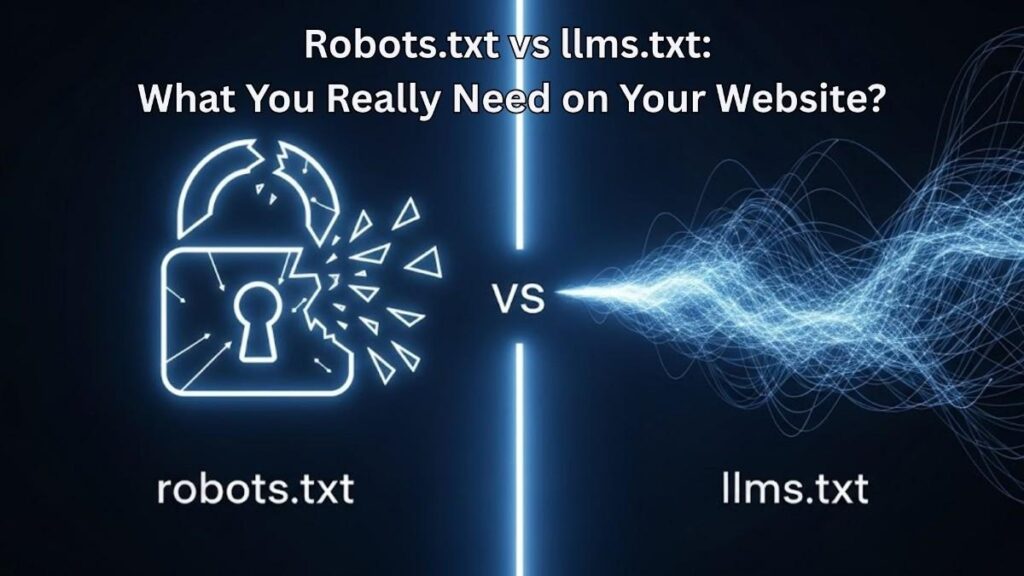When it comes to optimizing your website for both search engines and modern AI technologies, two files have started to stand out: robots.txt and the relatively new llms.txt.
The robots.txt file has been around for decades and plays a vital role in SEO by guiding search engine crawlers on what parts of a website they can or cannot index. On the other hand, llms.txt has emerged as a way to communicate with large language models (LLMs), AI systems like ChatGPT and Bard that rely on vast amounts of data from the web.
As more content gets consumed by both search engines and AI, understanding the differences between these two files is crucial for webmasters, marketers, and businesses working with a professional SEO company in India.
Understanding Robots.txt
The robots.txt file is one of the oldest standards in the world of SEO. Located in the root directory of a website (e.g., www.example.com/robots.txt), it tells search engine bots what they’re allowed to crawl.
Structure of Robots.txt
The syntax of robots.txt is simple and rule-based. It consists of User-agent declarations followed by rules like Allow and Disallow.
Example:
User-agent: * Disallow: /private/ Allow: /public/
- User-agent: Specifies which crawler the rule applies to (e.g., Googlebot, Bingbot).
- Disallow: Blocks crawlers from accessing certain pages or directories.
- Allow: Grants access to specific paths, even within disallowed sections.
Why Robots.txt Matters
- Prevents duplicate content issues.
- Controls crawl budget, ensuring bots focus on important pages.
- Enhances site security by blocking sensitive directories from being crawled.
For businesses partnering with a leading SEO company in India, having a well-structured robots.txt is a basic yet powerful step toward efficient site management.
Emergence of llms.txt
With the rise of AI-driven content consumption, the llms.txt file has been proposed as a complementary tool to robots.txt. Unlike robots.txt, which governs search engine crawlers, llms.txt is meant for large language models that scrape or reference online content for training.
Purpose of llms.txt
- Guides AI models on what website content can be used.
- Allows content creators to set boundaries on how their data is consumed.
- Improves ethical data usage by giving AI developers clear rules.
Example of llms.txt Directives
Allow: /blog/ Disallow: /premium-content/ Contact: admin@example.com
This file could tell AI systems to use blog content freely but avoid proprietary resources or paid sections.
Benefits for Site Owners
- Protects intellectual property.
- Balances content visibility with brand protection.
- Encourages transparent AI usage practices.
For content-driven businesses, especially those leveraging the expertise of an seo agency in India, llms.txt can add a layer of control over how AI interacts with their brand.
Are you enjoying reading this blog post?
If you’re interested in having our team handle your marketing needs, please click here
Comparative Analysis
Feature | robots.txt | llms.txt |
Audience | Search engine crawlers | AI language models |
Purpose | Control crawling & indexing | Control data usage in AI training |
Common Directives | Disallow, Allow, Sitemap | Allow, Disallow, Contact |
Impact on SEO | Direct | Indirect (via content protection) |
When to Use Robots.txt vs llms.txt
- Use robots.txt when your priority is search engine optimization and ranking.
- Use llms.txt when your concern is AI data usage and content protection.
- For maximum control, use both, since they serve different but complementary audiences.
Potential Conflicts
In rare cases, a site may allow crawlers in robots.txt but disallow LLMs in llms.txt. Site owners should align both strategies to avoid contradictions.
Best Practices for Implementation
Step 1: Creating Robots.txt
- Open a plain text editor.
- Write rules for bots (e.g., Googlebot).
- Save as robots.txt.
- Upload to the root directory of your domain.
Step 2: Creating llms.txt
- Draft rules for AI models.
- Add contact details for queries.
- Save as llms.txt.
- Place it in the root directory.
Tools & Resources
- Google Search Console – to test robots.txt.
- Robots.txt Tester tools – available online.
- Community guides for llms.txt (still evolving).
Conclusion
As the digital world evolves, so do the tools we need to manage it. Robots.txt remains a cornerstone of SEO strategy, while llms.txt is shaping up to be an important standard for the AI era.
Website owners should embrace both files, robots.txt for search engines and llms.txt for AI models, to secure their online presence and protect their content.
If you want to maximize your website’s visibility and ensure its future-proofing against both search engine and AI challenges, partnering with a professional SEO company in India can make all the difference.
👉 Explore more insights and tailored SEO solutions at Magnarevo.
About Author
Raised in India, I earned a Masters in Marketing from Swinburne University. Initially in Sales, I pivoted to Digital Media in 2013. Now, as the driving force behind Magnarevo, I leverage my expertise to guide branding and marketing, leading our sales and marketing teams. Keen on collaborations, I guide businesses to elevate their digital presence. Reach out at karan@magnarevo.com. Specialities: Branding, marketing strategy, digital media, ad management, website development, and analytics.
